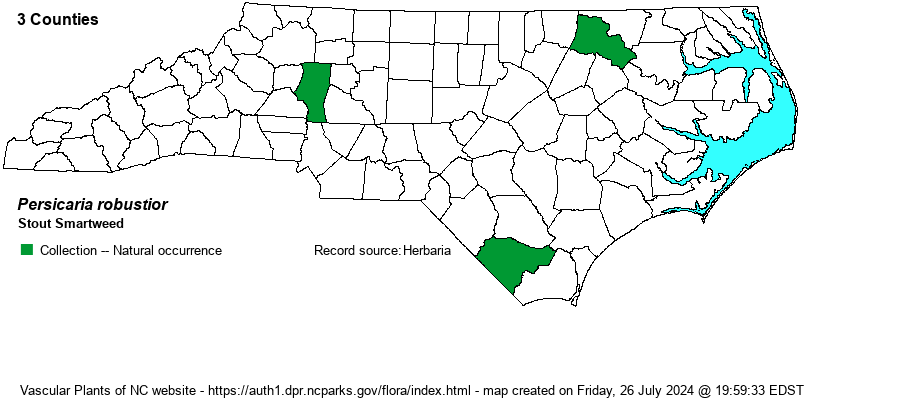| Author | (Small) E.P. Bicknell | |
| Distribution | Weakley's (2022) map shows only the Coastal Plain. SERNEC has only three specimens -- Iredell, Halifax, and Columbus. However, as this taxon is very similar to P. punctata, which is widespread, it is likely that few taxonomists have re-examined those specimens of the latter species.
"NS, QC, MI, MO, south irregularly to s. FL and TX, and south into tropical America" (Weakley 2022). | |
| Abundance | Presumably very rare, but unknown. The Digital Atlas of Virginia Flora shows records just for two Coastal Plain counties -- i.e., rare, but noting that the map is probably very incomplete. As a result, the website editors suggest an NC State Rank of [S1?] and a Watch List status. | |
| Habitat | "Peaty shores or semi-aquatic in water" (Weakley 2022). | |
| Phenology | Flowers and fruits from July into November. | |
| Identification | Very similar to the common P. punctata -- which has greenish-white scattered flowers on the inflorescence -- by having "Inflorescences not interrupted; ocreolae usually overlapping, the margins usually eciliate or with cilia < 1 mm long; leaves 2-4.5 cm wide", as opposed to "Inflorescences interrupted; ocreolae mostly not overlapping (especially the lower), the margins mostly ciliate with hairs < 2 mm long; leaves 0.6-2.4 cm wide" in P. punctata. Thus, P. robustior leaves are usually more than 1-inch wide, and up to nearly 2 inches wide, with more flowers crowded on the stalk; P. punctata leaves are always less than 1-inch wide, with gaps in the flowering stalk. | |
| Taxonomic Comments | This is a somewhat older name, but many or most references/authors have included it within P. punctata. However, NatureServe does consider it a valid species.
Many species formerly treated in the genus Polygonum have been moved to Persicaria, the smartweeds. These are generally erect and tall plants with terminal and axillary floral spikes; most occur in wetlands. Others remain in Polygonum, the knotweeds, which are generally prostrate to ascending and with inconspicuous axillary flowers. They occur mostly in dry soils and tend to be weedy.
Attention must be paid to the small collars at the junction of the main stem and leaf stems (called ocreae) and whether they possess terminal hairs or bristles. Some keys also refer to the even smaller collars from which flowers emerge (called ocreolae). Another important ID character is the surface of the greenish sepals -- whether smooth or dotted with indentations (punctate). | |
| Other Common Name(s) | Water Smartweed | |
| State Rank | [S1?] | |
| Global Rank | G4G5 | |
| State Status | [W7] | |
| US Status | | |
| USACE-agcp | | |
| USACE-emp | | |

